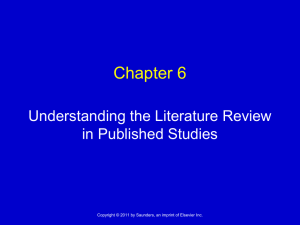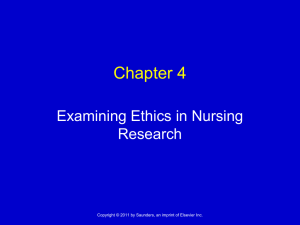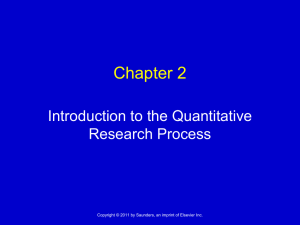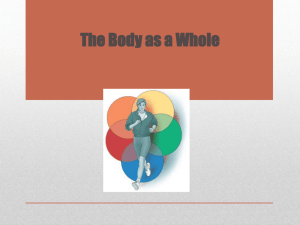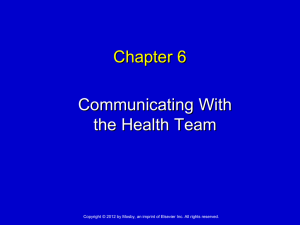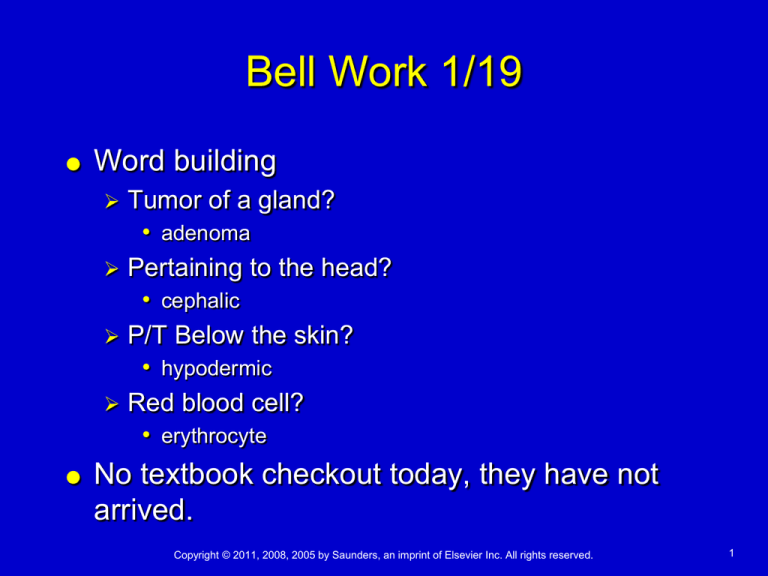
Bell Work 1/19
Word building
Tumor of a gland?
• adenoma
Pertaining to the head?
• cephalic
P/T Below the skin?
• hypodermic
Red blood cell?
• erythrocyte
No textbook checkout today, they have not
arrived.
Copyright © 2011, 2008, 2005 by Saunders, an imprint of Elsevier Inc. All rights reserved.
1
Chapter 2
Terms Pertaining to the
Body as a Whole
Copyright © 2011, 2008, 2005 by Saunders, an imprint of Elsevier Inc. All rights reserved.
2
Chapter Goals
Define terms that apply to the structural
organization of the body.
Identify the body cavities and recognize the
organs contained within those cavities.
Locate and identify the anatomical and
clinical divisions of the abdomen.
Locate and name the anatomical divisions of
the back.
Copyright © 2011, 2008, 2005 by Saunders, an imprint of Elsevier Inc. All rights reserved.
3
Chapter Goals (cont’d)
Become acquainted with terms that describe
positions, directions, and planes of the body.
Identify the meanings for new word elements
and use them to understand medical terms.
Copyright © 2011, 2008, 2005 by Saunders, an imprint of Elsevier Inc. All rights reserved.
4
Structural Organization of the Body
CELLS–
the fundamental unit of all living things
TISSUES–
a group of similar cells working
together to do a specific job
ORGANS—
types of tissue combine to form an
organ
SYSTEMS–
groups of organs
Copyright © 2011, 2008, 2005 by Saunders, an imprint of Elsevier Inc. All rights reserved.
5
Structural Organization of the Body
CELL—the fundamental unit of all living things
Major parts of a
cell include:
chromosomes
nucleus
cell membrane
cytoplasm
Copyright © 2011, 2008, 2005 by Saunders, an imprint of Elsevier Inc. All rights reserved.
6
Study Section 1– these terms
are defined on page 35
anabolism
catabolism
cell membrane
chromosomes
cytoplasm
DNA
endoplasmic
reticulum
genes
karyotype
metabolism
mitochondria
nucleus
Copyright © 2011, 2008, 2005 by Saunders, an imprint of Elsevier Inc. All rights reserved.
7
Structural Organization of the Body
Cells are specialized to
carry out individual
functions.
Identify the following in
the image
Epithelial cell
Fat cell
Nerve cell
Muscle cell
Copyright © 2011, 2008, 2005 by Saunders, an imprint of Elsevier Inc. All rights reserved.
8
Structural Organization of the Body
(cont’d)
Types of Cells
Copyright © 2011, 2008, 2005 by Saunders, an imprint of Elsevier Inc. All rights reserved.
9
Structural Organization of the Body
Tissues
Different tissue types include:
Epithelial Tissue — tissues that line internal
organs and is the outer most layer of our skin
Muscle Tissue – three types of muscle tissue
Involuntary
Voluntary
Cardiac
Connective Tissue – fat, cartilage, bone and blood
Nerve Tissue – conducts impulses
Copyright © 2011, 2008, 2005 by Saunders, an imprint of Elsevier Inc. All rights reserved.
10
Structural Organization of the Body
Organs: Different types of tissue combine
to form an organ
The stomach is composed of muscle, nerve,
and epithelial tissues.
Internal organs is called viscera
Systems: Groups of organs working
together to perform complex functions
Page 37 has a list of systems
Copyright © 2011, 2008, 2005 by Saunders, an imprint of Elsevier Inc. All rights reserved.
11
Vocabulary
adipose tissue
Cartilage
skin cells that cover the body and internal surfaces
of organs
Histologist
connective tissue that attaches bones at joints
epithelial cells
collection of fat cells
Specialist in the study of tissues. Hist = tissue
Larynx
“Voice box” – the upper part of the trachea
Copyright © 2011, 2008, 2005 by Saunders, an imprint of Elsevier Inc. All rights reserved.
12
Vocabulary
pharynx
pituitary gland
Gland at the base of the brain, often referred to as
the master gland
thyroid gland
throat
Gland that surrounds the trachea
trachea
“windpipe” Tube that leads from the throat to the
bronchial tubes
Copyright © 2011, 2008, 2005 by Saunders, an imprint of Elsevier Inc. All rights reserved.
13
Body Cavities and Organs
Cavity
Organ(s)
Cranial
Brain
Thoracic
Lungs and heart
Abdominal
Stomach, small and large
intestines, spleen, pancreas
Pelvic
Portions of the small and large
intestines, bladder, rectum
Spinal
Nerves of the spinal cord
Copyright © 2011, 2008, 2005 by Saunders, an imprint of Elsevier Inc. All rights reserved.
14
Vocabulary
Ureter
Urethra
Tube from the bladder to the outside of the body
Uterus
Tube that leads from the kidney to the bladder
The womb
Viscera
Internal organs
Copyright © 2011, 2008, 2005 by Saunders, an imprint of Elsevier Inc. All rights reserved.
15
Review
Cystoscopy:
A. Study of cells
B. Visual examination of cells
C. Removal of a sac of fluid
D. Removal of the urinary
bladder
E. Visual examination of the
urinary bladder
Electroencephalogram:
A. Record of electricity in the
brain
B. Record of electricity in the
heart C. X-ray of the brain
D. Record of sound waves in
the brain
E. X-ray of the heart and brain
Cancerous tumor:
A. Hematoma
B. Adenoma
C. Carcinoma
D. Carcinogenic
E. Neurotomy
Pain in a joint:
A. Ostealgia
B. Arthritis
C. Osteoarthritis
D. Arthroalgia
E. Arthralgia
Copyright © 2011, 2008, 2005 by Saunders, an imprint of Elsevier Inc. All rights reserved.
16
Body Cavities
Body cavities are the
spaces within the body
that contain internal
organs (viscera).
Copyright © 2011, 2008, 2005 by Saunders, an imprint of Elsevier Inc. All rights reserved.
17
QUICK QUIZ:
1. Which body cavity contains the
pleural cavity and the
mediastinum?
A. cranial
B. pelvic
C. spinal
D. thoracic
Copyright © 2011, 2008, 2005 by Saunders, an imprint of Elsevier Inc. All rights reserved.
18
QUICK QUIZ: (cont’d)
2. Which body cavity contains the
peritoneum?
A. abdominal
B. pelvic
C. spinal
D. thoracic
Copyright © 2011, 2008, 2005 by Saunders, an imprint of Elsevier Inc. All rights reserved.
19
Bell work 1/24
Match the parts of the body with their correct descriptions:
a.adipose tissue
1.
2.
3.
4.
5.
6.
7.
8.
e.pleura
b.cartilage
f.trachea
c.larynx
g.ureter
d.pharynx
h.urethra
Throat
Collection of fat cells
Windpipe
Tube from the kidney to the urinary bladder
Voice box
Membrane surrounding the lungs
Flexible connective tissue at joints
Tube from the urinary bladder to outside of body
Copyright © 2011, 2008, 2005 by Saunders, an imprint of Elsevier Inc. All rights reserved.
20
Organs of the Abdominopelvic
and Thoracic Cavities
Copyright © 2011, 2008, 2005 by Saunders, an imprint of Elsevier Inc. All rights reserved.
21
Study Section 3
abdominal cavity
Space below the chest that contains the liver,
stomach, gallbladder and intestines
cranial cavity
Space in the head that contains the brain, skull
diaphragm
Muscle that separates the thoracic and abdominal
cavities.
Copyright © 2011, 2008, 2005 by Saunders, an imprint of Elsevier Inc. All rights reserved.
22
Study Section 3
dorsal (posterior)
mediastinum
Centrally located space between the lungs
pleura
Pertaining to the back
Membrane surrounding each lung
pleural cavity
Space between the pleural membrane
Copyright © 2011, 2008, 2005 by Saunders, an imprint of Elsevier Inc. All rights reserved.
23
Study Section 3
spinal cavity
Space within the spinal column (backbone) and
contains the spinal cord.
thoracic cavity
Space in the chest containing the heart, lungs,
bronchial tubes, trachea, esophagus, and other
organs
ventral (anterior)
Pertaining to the front
Copyright © 2011, 2008, 2005 by Saunders, an imprint of Elsevier Inc. All rights reserved.
24
Abdominopelvic Regions and
Quadrants
Regions
Right Hypochondriac region
Left Hypochondriac region
Epigastric region
Right Lumbar region
Left Lumbar region
Umbilical region
Right Inguinal region
Left Inguinal region
Hypogastric region
Copyright © 2011, 2008, 2005 by Saunders, an imprint of Elsevier Inc. All rights reserved.
25
Abdominopelvic Regions (cont’d)
Copyright © 2011, 2008, 2005 by Saunders, an imprint of Elsevier Inc. All rights reserved.
26
Abdominopelvic Regions and
Quadrants
Quadrants
Right upper quadrant (RUQ)
Left upper quadrant (LUQ)
Right lower quadrant (RLQ)
Left lower quadrant (LLQ)
Copyright © 2011, 2008, 2005 by Saunders, an imprint of Elsevier Inc. All rights reserved.
27
Abdominopelvic Quadrants
Copyright © 2011, 2008, 2005 by Saunders, an imprint of Elsevier Inc. All rights reserved.
28
Abdominopelvic Quadrants
Copyright © 2011, 2008, 2005 by Saunders, an imprint of Elsevier Inc. All rights reserved.
29
Anatomical Divisions of the Back
Cervical
Thoracic
Loin or flank region. There are 5 lumbar vertebrae
Sacral
Chest region. There are 12 thoracic vertebrae
Lumbar
Neck region. There are 7 cervical vertebrae
Five bones that fuse together form the sacrum.
Coccygeal
The tailbone. A small bone of four fused pieces
Copyright © 2011, 2008, 2005 by Saunders, an imprint of Elsevier Inc. All rights reserved.
30
Anatomical Divisions of the Back
Copyright © 2011, 2008, 2005 by Saunders, an imprint of Elsevier Inc. All rights reserved.
31
QUICK QUIZ:
3. Name the abdominopelvic region
that is located in the central region
near the navel.
A. inguinal
B. umbilical
C. lumbar
D. hypochondriac
Copyright © 2011, 2008, 2005 by Saunders, an imprint of Elsevier Inc. All rights reserved.
32
QUICK QUIZ:
(cont’d)
4. Name the abdominopelvic region
that is located in the lower middle
below the umbilical region.
A. inguinal
B. epigastric
C. lumbar
D. hypogastric
Copyright © 2011, 2008, 2005 by Saunders, an imprint of Elsevier Inc. All rights reserved.
33
Bell Work 1.24
What area of the spine is at the neck?
What word means incision into a bone?
Cervical spine
Osteotomy
What cavity surrounds the lungs
Pleural cavity
Copyright © 2011, 2008, 2005 by Saunders, an imprint of Elsevier Inc. All rights reserved.
34
Positions, Directions, and
Planes of the Body
Positional and Directional Terms
Anterior (ventral) -- the front side of the body
Posterior (dorsal) -- the back side of the body
Deep -- away from the surface
Superficial -- on the surface
Proximal -- near the point of attachment
Distal -- far from the point of attachment
Inferior -- below another structure
Superior -- above another structure
Copyright © 2011, 2008, 2005 by Saunders, an imprint of Elsevier Inc. All rights reserved.
35
Positional and Directional Terms
Copyright © 2011, 2008, 2005 by Saunders, an imprint of Elsevier Inc. All rights reserved.
36
Positions, Directions, and
Planes of the Body
Positional and Directional Terms (cont’d)
Medial – pertaining to the middle
Lateral – pertaining to the side
Supine – lying on the back
Prone – lying on the belly
Copyright © 2011, 2008, 2005 by Saunders, an imprint of Elsevier Inc. All rights reserved.
37
Positions, Directions, and
Planes of the Body (cont'd)
Planes of the Body – an imaginary flat
surface
Frontal (coronal)
a vertical plane dividing the body into anterior and posterior
portions
Sagittal (lateral)
a lengthwise vertical plane dividing the body into right and left
sides
Transverse (cross-sectional or axial)
a plane running across the body parallel to the ground
Copyright © 2011, 2008, 2005 by Saunders, an imprint of Elsevier Inc. All rights reserved.
38
Positional and Directional Terms
Copyright © 2011, 2008, 2005 by Saunders, an imprint of Elsevier Inc. All rights reserved.
39
Combining Forms, Suffixes,
and Prefixes
COMBINING FORMS
Combining Form
Meaning
abdomin/o
abdomen
adip/o
fat
anter/o
front
bol/o
to cast (throw)
Copyright © 2011, 2008, 2005 by Saunders, an imprint of Elsevier Inc. All rights reserved.
40
Combining Forms, Suffixes,
and Prefixes (cont’d)
COMBINING FORMS
Combining Form
Meaning
cervic/o
neck (of the body or uterus)
chondr/o
cartilage
chrom/o
color
coccyg/o
coccyx (tailbone)
Copyright © 2011, 2008, 2005 by Saunders, an imprint of Elsevier Inc. All rights reserved.
41
Combining Forms, Suffixes,
and Prefixes (cont’d)
COMBINING FORMS
Combining Form
Meaning
crani/o
skull
cyt/o
cell
dist/o
far, distant
dors/o
back portion of the body
Copyright © 2011, 2008, 2005 by Saunders, an imprint of Elsevier Inc. All rights reserved.
42
Combining Forms, Suffixes
and Prefixes (cont’d)
COMBINING FORMS
Combining Form
Meaning
hist/o
tissue
ili/o
ilium (of the pelvic bone)
inguin/o
groin
kary/o
nucleus
Copyright © 2011, 2008, 2005 by Saunders, an imprint of Elsevier Inc. All rights reserved.
43
Combining Forms, Suffixes,
and Prefixes (cont’d)
COMBINING FORMS
Combining Form
Meaning
later/o
side
lumb/o
lower back
medi/o
middle
nucle/o
nucleus
Copyright © 2011, 2008, 2005 by Saunders, an imprint of Elsevier Inc. All rights reserved.
44
Combining Forms, Suffixes,
and Prefixes (cont’d)
COMBINING FORMS
Combining Form
Meaning
pelv/i
pelvis
poster/o
back, behind
proxim/o
nearest
sacr/o
sacrum
Copyright © 2011, 2008, 2005 by Saunders, an imprint of Elsevier Inc. All rights reserved.
45
Combining Forms, Suffixes,
and Prefixes (cont’d)
COMBINING FORMS
Combining Form
Meaning
sarc/o
flesh
spin/o
spine, backbone
thel/o
nipple
thorac/o
chest
trache/o
trachea, windpipe
Copyright © 2011, 2008, 2005 by Saunders, an imprint of Elsevier Inc. All rights reserved.
46
Combining Forms, Suffixes,
and Prefixes (cont’d)
COMBINING FORMS
Combining Form
Meaning
umbilic/o
navel, umbilicus
ventr/o
belly side of the body
vertebro
vertebra(e), backbone(s)
viscer/o
internal organs
Copyright © 2011, 2008, 2005 by Saunders, an imprint of Elsevier Inc. All rights reserved.
47
Combining Forms, Suffixes,
and Prefixes (cont’d)
PREFIXES
Combining Form
Meaning
ana-
up
cata-
down
epi-
above
hypo-
below
inter-
between
meta-
change
Copyright © 2011, 2008, 2005 by Saunders, an imprint of Elsevier Inc. All rights reserved.
48
Combining Forms, Suffixes,
and Prefixes (cont’d)
SUFFIXES
Suffix
Meaning
-eal
-iac
-ior
-ism
-ose
-plasm
-somes
-type
pertaining to
pertaining to
pertaining to
process, condition
pertaining to, full of
formation
bodies
picture, classification
Copyright © 2011, 2008, 2005 by Saunders, an imprint of Elsevier Inc. All rights reserved.
49
QUICK QUIZ:
5. Which term means process of
cutting the skull?
A. thoracotomy
B. craniotomy
C. diskectomy
D. arthroscopy
Copyright © 2011, 2008, 2005 by Saunders, an imprint of Elsevier Inc. All rights reserved.
50


